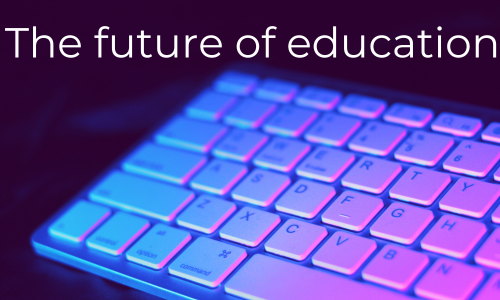The future of education: How technology is changing the landscape

What will the future of education look like? It’s impossible to truly know, but emerging technologies offer the potential to enhance, or even transform, the way we teach and learn.
Here, we explore some of the most exciting emerging technologies in education and ask, as an educator, how you can stay ahead of the curve. Let’s find out more…
Artificial intelligence (AI) and personalised learning
We begin with the hot topic of Artificial Intelligence (AI). Rapidly emerging AI technology analyses educational data to understand learner performance, reveal trends in education and personalise content to suit learners’ needs.
E-learning has already enabled more widespread and inclusive learning in recent years. Now, adaptive learning software and assistive technology devices are taking things a step further. Style, pace and difficulty can be closely tailored to individual learner requirements and lead to increased understanding, engagement and motivation.
Artificial Intelligence can never diminish or replace the value of teaching but, used smartly, it can help educators to make more informed decisions and improve learning outcomes for students. It can also help you to reach learners of differing abilities more effectively and streamline administrative tasks, saving valuable time and energy.
Virtual, augmented and mixed reality
School field trips to Machu Picchu or the moon? It’s all possible with virtual, augmented or mixed reality technologies!
Virtual reality (VR) is a computer-generated simulation that allows learners to interact with a three-dimensional environment using a wearable headset. Augmented reality (AR) is similar, but uses computer-generated technology to enhance a real-world experience and can be used with laptops, tablets and smartphones. While mixed reality incorporates elements of VR and AR and allows the virtual environment to interact with the real world and be manipulated.
Immersive technologies open up a multitude of possibilities in education. In addition to being transported to far-flung locations, learners can experience historical events or participate safely in practical science experiments. They can hone their public speaking skills or expand cultural awareness on a virtual tour of world-famous museums and art galleries.
For language learners, VR software and audio visual tools provide an immersive learning experience without the need for expensive long-distance travel. Virtual reality language services enable real conversations, making language learning more enjoyable and applicable to real-life scenarios.
As part of a blended curriculum, VR, AR and mixed reality technologies can encourage empathy, understanding and a global outlook in students. Recent research has shown that immersive technologies can also boost learner engagement, leading to increased motivation and improved results.
Educational gaming
Another exciting development in educational technology is the rise of educational gaming or ‘gamification’ as it’s sometimes known. Incorporating elements of AI and immersive technologies, game-based learning platforms have the potential to significantly impact the future of education.
Essentially, game-based learning platforms are designed to appeal to students. They promote learner engagement using feedback and reward structures like badges, points or leaderboards. Learners are motivated to keep trying and they enjoy the challenge of progressing through levels.
Gamification can be particularly effective for less popular subjects like Maths, helping to engage learners in a classroom setting and improve knowledge retention. Educational games can also improve a wide range of real-world skills, from collaboration and critical thinking, to problem-solving and communication.
Looking to the future, as AI becomes more sophisticated and integrated into gaming, it may speed up the development of games-based learning and increasingly personalise gaming experiences.
For educators, the challenge lies in maintaining a balance between games-based learning and traditional teaching. We don’t have long-term data on the impact of educational gaming but, used carefully, it can supplement classroom instruction and give learners extra opportunities to practise and reinforce their learning.
Final thoughts…
We’ve given you a round up of some of the most exciting emerging technologies in education. The pace of change can sometimes feel overwhelming but, used effectively, these emerging technologies offer an amazing opportunity to make classroom experiences more meaningful. As an educator, an open-minded and curious outlook will help you to embrace change and adapt.
Interested in finding out more about emerging technologies in education and how you can utilise them in your classroom? Contact our expert team
Subscribe to our Mailing List
For news, product updates, offers and more, signup to our newsletter. See our Privacy Policy here
